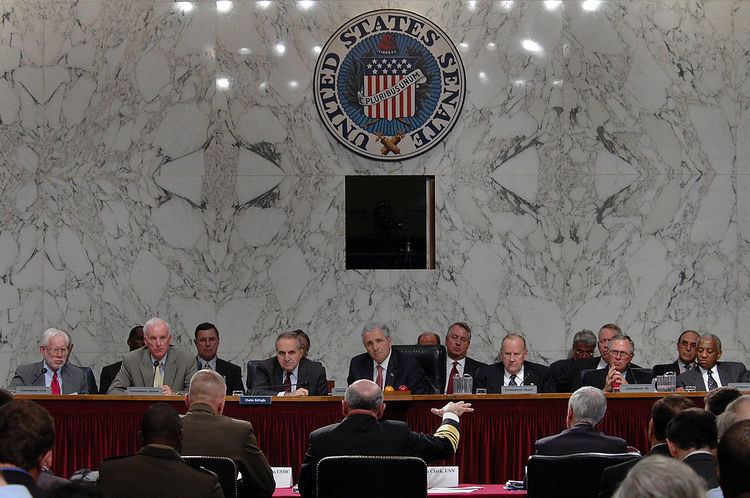The 2005 Base Realignment and Closure Commission preliminary list was released by the United States Department of Defense on May 13, 2005. It was the fifth Base Realignment and Closure ("BRAC") proposal generated since the process was created in 1988. It recommended closing 22 major United States military bases and the "realignment" (either enlarging or shrinking) of 33 others. On September 15, 2005, President George W. Bush approved the BRAC Commission's recommendations, leaving the fate of the bases in question to the United States Congress. Congress had a maximum of 45 days to reject the proposal by passing a joint resolution of disapproval, or the recommendations automatically enter into effect. Such a resolution (H.J.Res. 65) was introduced to the House of Representatives on September 23, 2005, by Rep. Ray LaHood (R-IL) (no such resolution was introduced in the Senate). The House took up debate of the resolution on October 26, 2005. The resolution failed to pass by a 324-85 margin, thereby enacting the list of recommendations. The Secretary of Defense was required to begin implementing the recommendations by September 15, 2007 and to complete implementation no later than September 15, 2011.
Anthony J. Principi, ChairmanJames H. BilbrayPhilip CoyleHarold W. Gehman, Jr.James V. HansenJames T. HillLloyd W. NewtonSamuel K. SkinnerSue E. TurnerPentagon officials calculated that, if adopted in full by the nine-member BRAC Commission, the recommendations would have saved almost $50 billion over 20 years. The BRAC Commission (officially known as the Defense Base Closure and Realignment Commission) disputed this claim, pointing out what it considered to be significant flaws in the Department's methodology. The Commission recalculated the 20-year savings of the DOD recommendation list at just above $37 billion. Between late May and late August, the Commission reviewed the list and amended many of the Pentagon's recommendations, removing several major installations from the closure list. The Commission calculated the overall 20-year savings to the government in carrying out its amended list of recommendations as close to $15 billion.
Gen. Richard Myers, Chairman of the Joint Chiefs of Staff, said on May 12, 2005 that the two-year effort to produce the list had several objectives:
better integrate active and reserve unitsrearrange forces to be able to act around the globemake the military more flexible and agileimprove cooperation between military service branches while training and fightingconvert unneeded capacity into warfighting capabilityThe 2005 BRAC round is the fifth since the process was initiated in 1988, and it is the first since 1995. It differs significantly from its predecessors in several respects:
It is the first with a nine-member commission (the 1991, 1993, and 1995 commissions had eight members)It is the only stand-alone round authorized by Congress (the 1988 BRAC round was initiated by the Secretary of Defense, and the 1991–1995 rounds were authorized together in the Defense Base Closure and Realignment Act of 1990)It is the first BRAC round focused on military force transformation, not infrastructure reductionIt is the only round to form part of a worldwide defense infrastructure review that includes similar examination of U.S. installations overseasIt is the first BRAC to significantly impact the National Guard, causing several states to file legal proceedings attempting to stay or cause recommendations to be thrown outMajor facilities slated for closure include these:
Fort McPherson, GeorgiaFort Gillem, GeorgiaNaval Submarine Base New London in Connecticut (removed from list August 24, 2005)Portsmouth Naval Shipyard in Kittery, Maine (removed from list August 26, 2005)Naval Air Station Brunswick in MaineEllsworth Air Force Base in South Dakota (removed from list August 26, 2005)Cannon Air Force Base in New Mexico (temporarily removed from closure August 26, 2005, pending review of new mission assignment; permanently removed from closure list following review and transferred to Air Force Special Operations Command)Fort Monmouth in New JerseyDefense Finance and Accounting Service in New YorkFort Monroe, VirginiaBrooks City-Base, TexasNaval Air Station Joint Reserve Base Willow Grove in Pennsylvania (portion retained as a non-flying Air National Guard facility)Naval Station Ingleside, TexasOtis Air National Guard Base, Massachusetts (removed from list August 26, 2005)Navy Supply Corps School (Athens, Georgia), relocated to Naval Station Newport, Rhode Island in 2011.Major facilities slated for realignment include these:
Army Human Resource Command (HRC) in Missouri, moving to the Fort Knox Military Installation in Kentucky.United States Army Armor School in Fort Knox, Kentucky, moving to the Maneuver Center of Excellence in Fort Benning, Georgia.Walter Reed Army Medical Center in Washington, D.C.Naval Station Great Lakes in IllinoisNaval Air Station Oceana in Virginia (extent contingent on reopening the former Naval Air Station Cecil Field in Florida)Grand Forks Air Force Base in North DakotaEielson Air Force Base and Elmendorf Air Force Base in AlaskaRome Laboratory in New YorkWright Patterson Air Force Base in OhioBrooke Army Medical Center in TexasWilford Hall Medical Center in TexasNaval Air Weapons Station China Lake in CaliforniaPope Air Force Base in North Carolina13 Joint Bases were created by merging adjacent installations belonging to different services.
The 2005 Base Realignment and Closure Commission resulted in a $35 billion increase in military spending, in part due to new facilities being built. The military claims, however, that it also resulted in a reduction of $4 billion in annual spending.

